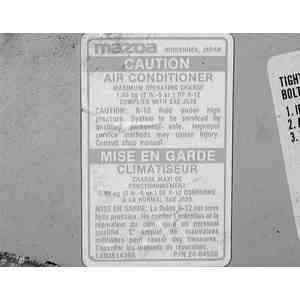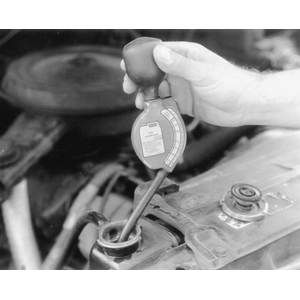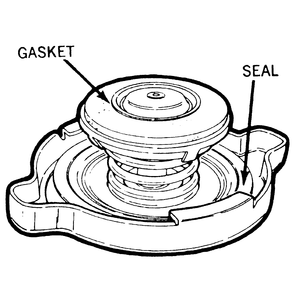| Fig. 1: A/C capacity sticker is located on the underside
of the hood — MPV shown

|
Although the A/C system should not be serviced by the do-it-yourselfer, preventive
maintenance can be practiced and A/C system inspections can be performed to
help maintain the efficiency of the vehicle's A/C system. For preventive maintenance,
perform the following:
- The easiest and most important preventive maintenance for your A/C system
is to be sure that it is used on a regular basis. Running the system for five
minutes each month (no matter what the season) will help ensure that the seals
and all internal components remain lubricated.
NOTE: Some newer vehicles automatically operate the A/C system
compressor whenever the windshield defroster is activated. When running, the
compressor lubricates the A/C system components; therefore, the A/C system would
not need to be operated each month.
In order to prevent heater core freeze-up during A/C operation, it is necessary
to maintain proper antifreeze protection. Use a hand-held coolant tester (hydrometer)
to periodically check the condition of the antifreeze in your engine's cooling
system.
| Fig. 2: A coolant tester can be used to determine the
freezing and boiling levels of the coolant in your vehicle

|
NOTE: Antifreeze should not be used longer than the manufacturer
specifies.
For efficient operation of an air conditioned vehicle's cooling system, the
radiator cap should have a holding pressure which meets manufacturer's specifications.
A cap which fails to hold these pressures should be replaced.
| Fig. 3: To ensure efficient cooling system operation,
inspect the radiator cap gasket and seal

|
Any obstruction of or damage to the condenser configuration will restrict
air flow which is essential to its efficient operation. It is, therefore, a
good rule to keep this unit clean and in proper physical shape.
NOTE: Bug screens which are mounted in front of the condenser
(unless they are original equipment) are regarded as obstructions.
The condensation drain tube expels any water which accumulates on the bottom
of the evaporator housing into the engine compartment. If this tube is obstructed,
the air conditioning performance can be restricted and condensation buildup
can spill over onto the vehicle's floor.

